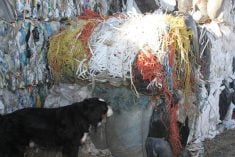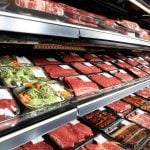About 90 percent of eggs eaten in North America come from hens living in battery cages.
However, confining hens in cages stacked in tiers in climate controlled barns may be on the way out as society questions the quality of life in these systems.
“All egg producers really should be considering the future of battery cages,” said Ian Duncan, a professor emeritus at the University of Guelph, Ont., who has devoted his career to investigating poultry welfare and behaviour.
“There is no doubt change is happening and consumers are becoming increasingly knowledgeable about animal welfare.”
Read Also

Canadian farmers need level playing field for regulations – says Minister MacDonald
Federal agriculture minister Heath MacDonald is urging the Canadian Food Inspection Agency and the Pest Management Regulatory Agency to speed up their decision making.
Duncan was speaking at a May 11 meeting in Calgary sponsored by the Animal Welfare Foundation of Canada, an independent organization that monitors humane care of animals and funds education and research at veterinary colleges. The meeting attracted egg producers, researchers and retailers.
He said moving away from battery cages has its disadvantages. Farmers may find the change difficult and costly. Conventional cages can last 25 years and renovations are expensive. As well, some question whether consumers are willing to pay more for eggs produced in new systems.
However, legislators in the European and United States are banning the battery cage.
The European Union’s hen directive bans the cages among member countries by 2012. California, the biggest egg producer in the U.S., plans to ban them by 2015. Michigan ends their use in 2019.
Manitoba Egg Farmers launched a policy last year that said hen husbandry should provide for the five freedoms of animal welfare and that all new housing facilities for laying hens will be required to meet those requirements after 2018.
Duncan said this is a different approach because farmers made the decision.
“The rest of the world has had to have legislation thrust upon them and here we have a group of farmers who have decided this is the way to go,” he said.
Duncan, who serves on Burger King’s animal care committee, said the company announced in 2006 that it wanted eggs only from non-caged hens. However, it has since decided to make the change incrementally.
Ten percent of Burger King’s eggs come from non-caged hens.
Loblaws is also working with industry to gradually offer eggs from cage free systems.
Cages were introduced more than 70 years ago and often contained one hen.
However, farmers increased production and reduced labour costs as demand grew for eggs. Chickens moved into confined systems that could fully automate feeding, drinking, egg collection and manure removal.
Farmers and researchers found that confinement reduced infections such as coccidiosis, salmonella, avian tuberculosis, pullorum disease and intestinal worm infestations.
There appeared to be fewer problems with feather picking and cannibalism.
However, Duncan said nearly 40 years of research have found welfare problems with cages.
“The normal dimensions of a battery cage may compromise welfare by restricting what hens can do.”
Birds that live in cages have nothing to do and are frustrated. Normal behaviours such as nesting, stretching, preening and roosting on a perch are not possible.
Chickens are a flocking species but do not like to be crowded together.
The normal height of a battery cages does not allow hens to adopt a common standing tall posture, which affects normal head stretching, scratching, body shaking and sitting.
Cages also don’t allow dust bathing. Birds have an oil gland in the front of the tail that they use to clean themselves and waterproof feathers. They dust bathe to remove stale oil, and there is also evidence that it is pleasurable for them.
Caged birds get no exercise, resulting in spent hens with weak skeletons, osteoporosis and low value carcasses.
Alternatives not perfect
Research is ongoing to find alternatives to battery cages, said Michelle Jendral, poultry behaviour and welfare professor at the Nova Scotia Agricultural College.
She said new systems are available that could improve birds’ lives, but none are perfect.
“These alternative housing options are indeed manageable options that can provide some of the benefits that cannot be addressed in conventional housing,” she said.
Options include enriched, furnished and colony systems and range from larger, fancier cages to more open barn systems. They all include areas to nest, perch and scratch and come in various sizes with lower stocking density so birds receive more floor and ceiling space.
Birds living in these systems have more to occupy their time, such as foraging for food and scratching their claws on a rough surface, which prevents the growth of long, twisted claws that can break off and lead to infection or injury.
“It is very important. When the birds are scratching, they are not preoccupied with pecking each other,” said Jendral.
This improves feather cover and reduces skin wounds that can lead to disease.
Access to a perch leads to healthier feet, but research is looking at better designs.
Colony systems or small aviaries are large spacious units with more height and larger groups, in which each bird receives 800 to 900 sq. centimetres of space. At least two perches are provided at different heights.
This system still allows for automated feeding, egg removal and manure removal but also provides better living conditions for the birds.
Extra cage height means more head and wing stretching, feather rustling, scratching and foraging. Birds also have stronger bones and maintain egg quality. But concerns remain.
“These birds are still in confined settings so the success is still dependent on a number of factors,” said Jendral.
More birds living together results in more social strife.
“We need to figure out what is the right stocking density and what is the right group size,” she said.
Layout is important. Some aviaries offer multi-tiered systems with slatted floors and platforms for perches, nesting, drinking and feeding areas.
However, genotype is equally important because some strains are calm while others are more flighty.
“Birds that I would have anticipated were very calm, but they reach a certain period where they don’t cope very well and they become very territorial,” she said.
Lower ranked birds struggle to gain access to perches, nests, feed and water. They may lose weight and cannot produce. Better management is also needed to control pecking and cannibalism because aggressive birds have more opportunity to misbehave in a large system.
Researchers are also looking at how to renovate a conventional system to meet legislative requirements.
“Just because it meets the legislative requirements, does it meet the hen’s needs?” she said. “We don’t necessarily have to go to extremes, but we have to consider what are the minimum requirements.”
Furnished cage systems require producers to improve their husbandry to address environmental and food safety issues as well as welfare. They must check birds more carefully and learn how to keep them calm and monitor how well they adjust to a more open system.
“If you freak them out, they are going to run away and trample and smother each other,” she said.
TYPES OF SYSTEMS:
• Conventional caged:These housing systems vary in size, but generally three or more birds are housed in each cage and cages are stacked on top of one another.
• Free run indoors:Hens are free to roam on floors of barns.
• Free range outdoors:Hens have access to outside.
• Enriched or modified cages:more space per hen than conventional cage and has enough room to encourage stretching, nesting behaviour and perching.
Note: Free run and free range housing may not necessarily provide more space for each hen.
Space provisions for adult laying hens:
Cage systems
•Canada: 432 sq. centimetres
•United States: 432 sq. cm
•McDonald’s in U. S: 464 sq. cm
•Burger King in U. S: 484 sq. cm
Caged or cage-free
•European Union: 550/750 sq. cm. Conventional battery cages to be phased out in 2012.
•SPCA certified: 1,111 sq. cm
•Certified Organic Canada: 1,667 sq. cm















